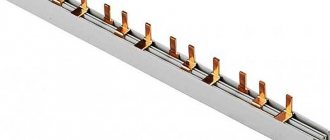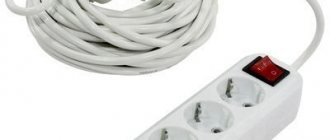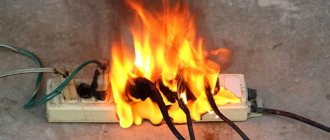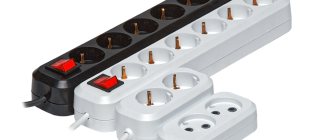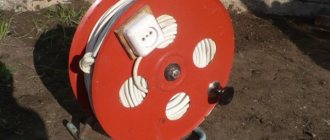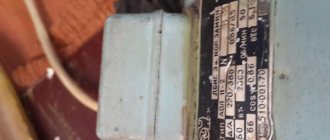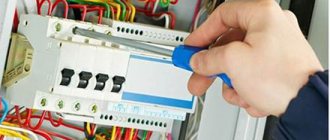Is it possible to install an electric stove in a private house?
But you can install an electric stove yourself, it is only important to install the communications correctly. Now there are various options for installing wiring in the house: in accessible cable channels, in grooves (closed version), under baseboards and under wall panels (if they are made, for example, of plasterboard).
Interesting materials:
How to cheer yourself up in 5 minutes? How to choose lenses for astigmatism? How to choose a spacer ring? How to reheat cooled khinkali? How to sign yourself in a WhatsApp chat? How to subscribe to your channel on YouTube? How to subscribe to Telegram on iPhone? How to feed a Navien boiler? How to pull data from one table to another Google Sheets? How to confirm a gold medal?
Wiring, its cross-section and machines
Connecting an oven with your own hands requires knowing some rules - we’ll tell you everything step by step. When thinking through the nuances, the first thing to do is to assess the condition of the existing wiring and find out its cross-section. If the wiring has been laid recently, done according to all the rules, a 2.5 mm cable goes to the socket group and there is a 16 A (or more) machine, you can connect any oven using a power cord, plug and socket. Everything is really simple, but there are disadvantages:
- While the oven is operating, it is impossible to turn on any powerful equipment in the same socket group - the machine will knock out.
- From time to time you will have to replace melted sockets, since they are not designed to carry significant currents for a long time.
If you agree with this, connecting the oven is really very simple: install, secure, turn on.
It is advisable to install wiring for connecting household appliances at the repair stage
It is not advisable to connect a heavy load to old wires, but if the wiring is in good condition, it is three-wire with a normally functioning grounding, this is possible. To check the condition of the insulation, we measure the insulation resistance of the cores. This is done using a megohmmeter. If the standards are met (at least 0.5 MOhm), the oven can be connected. One important point: the cross-section of the wire must be at least 2.5 mm 2 (copper), and a machine of a suitable rating (16 A) must be installed.
Core cross-section and machine rating
If you have to draw a new line, first you need to decide on the cross-section of the cable cores. On average, the maximum power consumption of ovens is 3-3.8 kW. But these are peak loads in which the equipment operates very rarely. In normal mode, consumption is rarely more than 2 kW.
However, it is correct to calculate the wiring specifically for maximum consumption. For cables with copper conductors, the recommended cross-section is 2.5 mm 2, the automatic machine is 16 A. This has a significant power reserve (recommended load up to 5.9 kW), but these are the recommendations of almost all manufacturers and only under such conditions they retain their warranty obligations.
Cable cross-section selection table
Another nuance: all modern household appliances are designed to be grounded. That's why the cables use three-core cables. For installation in a house or apartment, you can use VVGng, VVGngLs and its other non-flammable varieties. NYM is also suitable. These cables have an optimal price/quality ratio. You will need three-core ones - 3*2.5. Just when choosing, measure the diameter of the wire and calculate the cross-section. Too many manufacturers began to make the cores thinner than stated to save money. Therefore, control is mandatory.
When installing more powerful ovens - with built-in steam generators - it is recommended to use cables with a wire cross-section of 4 mm 2. A 25 A machine is installed on the line.
In general, connecting the oven to electricity with recommendations for the cable used and ratings of protective equipment (automatic devices) is described in detail in the product data sheet. And it’s better to listen to the manufacturer’s recommendations. They are not interested in breakdowns of their own products and issue recommendations with a margin of safety.
RCD - necessary or not
In addition to the automatic safety switch, it is recommended to install an RCD on the oven. The machine protects the line from overheating and short circuit currents. At the same time, it is not able to protect against breakdown of the body, and this is a real danger. That is why it is recommended to install a combination of RCD + AB or a difavtomat (a device that combines all functions). Then, if the insulation breaks down on the housing or if a phase is accidentally touched, no one will get hurt.
Wiring diagram for an oven with an RCD
The choice of RCD rating is simple: one step higher than the machine. If there is a 16 A circuit breaker on the line, the RCD should be 25 A. You also need to select the leakage current. For leased lines this is 10 mA.
Wiring methods
In general, it is customary to lay wiring hidden - in plaster or grooves. But it is dusty and destructive work that leaves noticeable marks. It’s good if everything can be easily fixed by re-pasting the wallpaper or repainting the walls. If not, you will have to use other cable routing methods.
The first way is to lay it in cable channels. These are plastic or metal boxes in which cables are laid. They are screwed to the walls and have removable covers. The aesthetics of such a solution is debatable. In some cases, simply running a cable attracts less attention. Another thing is that on flammable bases (wooden walls or ceilings) it must be pulled in a corrugated manner and this is definitely noticeable. In general, the option is possible, but not very beautiful.
Laying in a cable channel and a special plinth
The second way is to stretch the line in special skirting boards. They are taller and wider than usual, but the wire can be reached covertly, it is protected from mechanical damage, and the aesthetics of this solution are excellent. In addition, it is easy to do, without dust and any special problems.
Choosing a location for an outlet
If you are planning to connect the oven through an outlet installed on a dedicated line, the question immediately arises: where should it be installed. Here's the problem. In this case, the socket and plug are installed as power ones, but their appearance, to put it mildly, is “not very good” and placing them above the work surface is unaesthetic. That’s why they are looking for a hidden installation method. This is where the problem arises: you need to find a place that makes it easy to turn on/off the equipment and that is safe (to exclude the possibility of water, dust, dirt, and mechanical damage). There are several options for solving the problem:
If the kitchen set has a plinth, install it behind the oven, a few centimeters above the floor level. Not the best option. There are many disadvantages. The first is difficult access. To turn the oven off/on from the mains, you have to almost lie down on the floor, sticking your hand all the way to the wall. The second is a high probability of contamination. In the kitchen, even under the furniture, grease and dirt accumulate. They will definitely be on the socket, which worsens contact and reduces electrical safety.
You can install a socket under the oven at the level of the baseboard
Option for installing a socket for connecting a dependent
The best option is in the locker nearby
A few words about choosing a socket and plug. If you install a 16 A machine, it makes sense to install electrical installation devices with the same rating. This guarantees long-term and uninterrupted operation without burning contacts or melting the case.
How to connect the power cable yourself
So, we have chosen a way to connect our primary kitchen devices. But our power cables are connected conditionally. Let's find out how to do it for real. Traditionally, we will consider separately the oven and hob.
For an oven (with a power of no more than 3.5 kW, P = 3.5 kW), you need to purchase a piece of PVA cable 3*2.5 and a regular 16A household plug. The cable length must be such that after connection the cable is not strained. When connecting to a plug (let's agree that the cable has brown, blue and yellow wires), it is important to connect the yellow (yellow-green) wire to the ground terminal. The order of connecting phase and zero is as follows: the brown wire is the phase, the blue wire is zero. In a socket, the phase can be determined using a phase indicator (any household appliance does not respond to the phase-zero order - if the TV plug is inserted opposite the current position, the TV will still work, however, it will be better to follow the operating conditions of this electrical appliance). Next, remove the small plastic cover at the cable connection point.
There we will see the connection for each cable core.
We will make the connection as follows: L is phase, N is zero, the earth sign is yellow (yellow-green are the colors of earth from an electrical point of view) according to the colors of the cores. Very important: the colors of the wire cores in the plug with a ground-phase-zero combination must correspond to a similar combination in the connected device. If the phase in the plug is the brown wire of the cable, then in the oven it is the brown wire. Exactly the same with zero and earth - purely by color.
Cooking surface. As a rule, hob models are universal. This means connecting to both 220V and 380V. The transition to both one and the other voltage is realized by installing the appropriate jumpers. On most hobs, at the point where the power cable is connected (a conveniently accessible plastic cover), you can see a similar connection diagram:
In the case of an apartment, where the allocated voltage is 220V, the output is obvious (in the case of a private house, with a allocated 380V, electricians adapt the power output to the hob to 220V).
In order for the hob to operate on 220 V, jumpers must be installed according to line 3 of the connection diagram. For a voltage of 380V, select line 1. In practice it might look like this:
As for the power cable, it is better to use PVS 3*6 (except for the case when the cable in the socket has a smaller cross-section - which is 3*4mm 2 ). In any case, it is recommended to adhere to the principle - the cross-section of the power cable cannot be less than the cross-section of the cable in the socket (the wire protruding from the wall to connect the hob). It can do more. As mentioned above, the hob is a large consumer of electricity. With a power of 7.3 kW (P=7.3kW), it is necessary to install a socket and plug designed for a current of 32A.
The combination of colors of cable cores with ground, phase and zero is completely similar to the case of an oven.
When connecting the power cables of the oven and hob, the brand of PVA cable was indicated. PVA is a flexible multi-core power cable in PVC insulation. But with a permanent connection to an electrical wiring cable (and this is in most cases a VVG-ng cable with monolithic inflexible cores), it would be more effective to use a cable of a similar brand. From the point of view of ease of connection, it is possible. From the point of view of operation, we are still dealing with household appliances, and they have some mobility. A monolithic cable is designed to be stationary; there is a possibility of core breakage, but not great. The probability of breakage of the connection points inside the device is already higher. Therefore, multicore cable (MCC) is more convenient in this case.
Because You are not logged in. To come in.
Because The topic is archived.
Step-by-step installation instructions
We found out what cable, socket and machine are needed. It remains to consider the process of installing the socket on the wall. This is a question that presents the greatest practical challenge, since the aesthetic component is important here. The wires must be hidden in the wall, the sockets must be installed firmly and as carefully as possible.
There are 2 installation options:
External socket (the housing is located outside, protruding from the wall)
Internal socket (all elements and connections are located in the wall niche, only a small part protrudes)
Connecting the cable/cord to the oven
Connecting an oven often involves the need to connect a cable or cord. For these purposes, there is a terminal block on the rear wall of the case. It is covered with a lid. The cover can be metal or plastic, held on by latches or screws. The options vary from manufacturer to manufacturer, but it’s impossible to make a mistake—there’s nothing else.
To 220 V network
First, remove the cover. Under it we see terminals with multi-colored wires connected on one side. If you are going to connect the oven to a 220 V network, there will be many more terminals than wires. Some are connected by jumpers. They must be installed, but can be checked. In general, the jumper installation diagram must be on the case. It can be embossed (as in the photo) or painted on (sticker).
What jumpers should be placed on the oven when connecting to a 220 V network?
For a single-phase 220 V network there must be three jumpers. Two phases connect - the first, second and third output. And one stands between the fourth and fifth.
Where to connect the cord
The wires from the cable/cord are connected as follows:
- To the third phase.
- By the fifth - neutral. The wire is blue or light blue.
- To zero (can be before the first or after the fifth) - grounding. With a yellow-green color.
The connection should be in exactly this sequence. Then the wires must be connected to the three-pin plug in this order: on the top pin - yellow-green, on the right - phase, on the left - zero (blue).
To 380 V network
When connecting to a three-phase network, there is only one jumper left - on the fourth and fifth terminals.
Read also: Shredding plastic with your own hands
Installation of jumpers for 380 V network
Connecting the cord conductors according to the following diagram.
Connecting the cord to the oven for a three-phase network
Your repost will change the Internet
